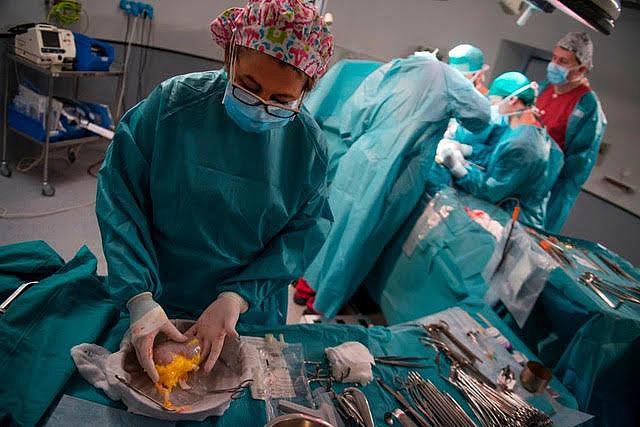Can smart reporting reduce the number of kidneys currently going to waste?

Pierre-Philippe Marcou/AFP/Getty Images
Nearly one out of every five kidneys donated in the United States ends up in the trash.
That’s a pretty stunning fact given there are a growing number of people in dire need of kidney transplants, driven by the increasing rate of people with diabetes, chronic kidney disease and other disorders that eventually kill kidney function.
A recent study in JAMA Internal Medicine shows the stark contrast between the way the United States and France handle kidney donations. In short, France throws away fewer kidneys. To be precise:
-
Out of 15,500 deceased kidney donors in France between January 1, 2004 and December 31, 2014, there were 29,984 kidneys recovered (nearly two for every donor). Among the recovered kidneys, 27,252 made it all the way to be transplanted. Another 2,732 were discarded, about 9%.
-
In the U.S., there were way more donors, of course: 78,517 deceased donors during the same period. As a result, more kidneys were recovered: 156,089. But look at how many were thrown away: nearly 18% or 27,987, while 128,102 were transplanted.
Why does this matter?
Every year, approximately 5,000 people die in the U.S. while waiting for a kidney.
This is part of a larger problem, of course. As has been well reported, France has far better health outcomes than the U.S. While the U.S. has seen the rate of illness and premature death start to rise in recent years, France continues to drive those rates lower. When you zero in on death rates from diabetes and kidney diseases, the contrast is even more stark, with death rates barely budging in the U.S. over the past decade and falling in France by nearly half.
But the core of the problem with kidney transplants relates more specifically to the organ donation system and how it works. One of the key problems with the U.S. system is how decisions are made about which kidneys to discard. As CNN’s Jen Christensen recently reported:
In comparison, in France, only about 9% of donated kidneys were discarded during the study period. The difference was because, in France, doctors were more willing to use older kidneys and kidneys from people who had other ailments such as diabetes or hypertension.
You can do the same thing the researchers who conducted this study did and make your findings even more current. They studied the period from 2004 and 2014. But the Organ Procurement and Transplantation Network updates its database fairly regularly. It produces annual reports, which lag a by a couple of a years, and keeps its database current within a few months. The latest annual report shows that the rate of discarded kidneys has continued to climb since the period that was studied, reaching a new high in 2017.
So examine the data. You can look at your state, your region, or each transplant center in your area. You can look at donors and recipients in in a wide variety of categories. There are stories to be told about waiting lists, about donor types, about recipient types, and a range of other areas.
Joseph Williams at U.S. News and World report hit upon a good theme ripe for exploration in a story about another recent scientific study:
Surgeons and kidney specialists likely rejected the available organs, the study suggests, after determining they weren't of sufficient quality or wouldn't meet a patient's long-term needs — even though the decision increased the odds that a transplant candidate would die.
That’s the heart of a good investigation right there. People who are waiting for a last chance at life are dying after that chance is tossed in the trash can without them knowing.
A good place to start would be to find out where most transplants are occurring in your area. One tool you can use is the Scientific Registry of Transplant Recipients (SRTR), which provides data on the organ transplant network via a contract with the U.S. Department of Health and Human Services.
I plugged in my area and found that the University of Washington Medical Center does the most kidney transplants by a big margin: 198 versus 94 at the next busiest transplant center. (Disclosure: The research institute where I work is part of the University of Washington.) In my old neighborhood, the University of California Los Angeles Medical Center does the most, with 262 kidneys from deceased donors and 119 from living donors. So find your top transplant center and talk with a nephrologist or surgeon from that center. What are their protocols? Have they changed over time? How do they communicate to patients when they are deciding to reject a kidney?
Next, find some people who are waiting on the kidney transplant list. Post something on some of your social media channels asking to talk to people who are waiting. Then go out looking for posts they may have put out there. There are often fundraisers for people on the list, awareness events that draw people, support groups that convene. It took me two minutes to find ways to contact actual patients or their families through Facebook, in Missoula, Montana; Columbus, Ohio; and Birmingham, Alabama.
The organ transplantation system improves and extends the lives of tens of thousands of people in the U.S. every year, and many more globally. (I have selected to be an organ donor on my driver’s license. Have you?) Investigating ways the system can be improved to help even more people is worth the effort and likely to yield just the kind of emotionally impactful and fact-based story you have been wanting to report.

